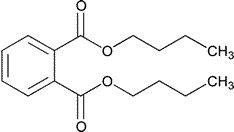Dibutyl Phthalate
»Dibutyl Phthalate contains not less than 99.0percent and not more than 101.0percent of C16H22O4.
Packaging and storage—
Preserve in tight containers.Store at room temperature,and avoid excessive heat and freezing.Protect from moisture.
USP Reference standards á11ñ—
USP Dibutyl Phthalate RS.
Appearance—
The substance is clear and not more intensely colored than a solution prepared immediately before use by mixing 2.4mLof ferric chloride CSand 0.6mLof cobaltous chloride CSwith dilute hydrochloric acid (10g per L)to make 10mL,and diluting 5mLof this solution with dilute hydrochloric acid (10g per L)to make 100mL.Make the comparison by viewing the substance and the solution downward in matched color-comparison tubes against a white surface (seeColor and Achromicity á631ñ).
Identification—
A:
Infrared Absorption á197Fñ,on undried specimen.
B:
It meets the requirements of the test forRefractive index.
Specific gravity á841ñ:
between 1.043and 1.048,at 20 .
.
Refractive index á831ñ:
between 1.490and 1.495,at 20 .
.
Acidity—
Mix 20.0g of Dibutyl Phthalate with 50mLof alcohol that previously has been neutralized to a phenolphthalein endpoint,add 0.2mLof phenolphthalein TS,and titrate with 0.1Nsodium hydroxide VS:not more than 0.50mLis required to change the color of the indicator.
Water,Method Iá921ñ:
not more than 0.2%.
Residue on ignition á281ñ:
not more than 0.1%,determined on 1.0g.
Related compounds—
Internal standard solution—
Transfer 30mg of dibenzyl to a 10-mLvolumetric flask,and dissolve in and dilute with methylene chloride to volume.
Test stock solution—
Transfer about 5.0g of Dibutyl Phthalate to a 50-mLvolumetric flask,and dissolve in and dilute with methylene chloride to volume.
Test solution 1—
Transfer 5.0mLofTest stock solution to a 10-mLvolumetric flask,and dilute with methylene chloride to volume.
Test solution 2—
Transfer 5.0mLofTest stock solution to a 10-mLvolumetric flask,add 1.0mLof Internal standard solution,and dilute with methylene chloride to volume.
Standard solution—
Transfer 1.0mLofTest solution 1to a 100-mLvolumetric flask,add 10.0mLof theInternal standard solution,and dilute with methylene chloride to volume.
Chromatographic system (seeChromatography á621ñ)—
The gas chromatograph is equipped with a flame-ionization detector and contains a 4-mm ×1.5-m column packed with 3%liquid phase G3on support S1A.The carrier gas is nitrogen,flowing at a rate of about 30mLper minute.The column temperature is maintained at 190 ,and the injection port temperature and the detector are maintained at 225
,and the injection port temperature and the detector are maintained at 225 .Chromatograph theStandard solution,and record the peak responses as directed forProcedure:the elution order is the internal standard peak followed by the dibutyl phthalate peak;and the resolution,R,between these peaks is not less than 12.ChromatographTest solution 1,and verify that there is no peak with the same retention time as the internal standard.If a peak observed in the chromatogram forTest solution 1has the same retention time as that for the internal standard,make any necessary correction for factors of dilution,and then determine the area due to the interfering component that must be subtracted from the area of the internal standard peak appearing in the chromatogram recorded forTest solution 2,as directed forProcedure.
.Chromatograph theStandard solution,and record the peak responses as directed forProcedure:the elution order is the internal standard peak followed by the dibutyl phthalate peak;and the resolution,R,between these peaks is not less than 12.ChromatographTest solution 1,and verify that there is no peak with the same retention time as the internal standard.If a peak observed in the chromatogram forTest solution 1has the same retention time as that for the internal standard,make any necessary correction for factors of dilution,and then determine the area due to the interfering component that must be subtracted from the area of the internal standard peak appearing in the chromatogram recorded forTest solution 2,as directed forProcedure.
Procedure—
Inject 1-µLportions ofTest solution 2and theStandard solution successively into the gas chromatograph,record the chromatograms for three times the retention time of dibutyl phthalate,and measure the responses of the peaks.From the chromatogram of theStandard solution,calculate the peak area ratio of dibutyl phthalate to the internal standard,A.From the chromatogram ofTest solution 2,calculate the peak area ratio of the sum of all peaks,excluding the main peak,the solvent peak,and the internal standard peak,to the internal standard peak:this ratio is not greater thanA(1.0%).
Assay—
Transfer about 0.75g of Dibutyl Phthalate,accurately weighed,to a flask,add 25.0mLof 0.5Nalcoholic potassium hydroxide VS,attach a reflux condenser to the flask,and boil in a water bath for 1hour.Add 1mLof phenolphthalein TS,and titrate immediately with 0.5Nhydrochloric acid VS.Perform a blank determination (seeResidual Titrations underTitrimetry á541ñ).Each mLof 0.5Npotassium hydroxide is equivalent to 69.59mg of C16H22O4.
Auxiliary Information—
Staff Liaison:Elena Gonikberg,Ph.D.,Scientist
Expert Committee:(EMC)Excipients:Monograph Content
USP28–NF23Page 2996
Pharmacopeial Forum:Volume No.30(3)Page 974
Phone Number:1-301-816-8251
